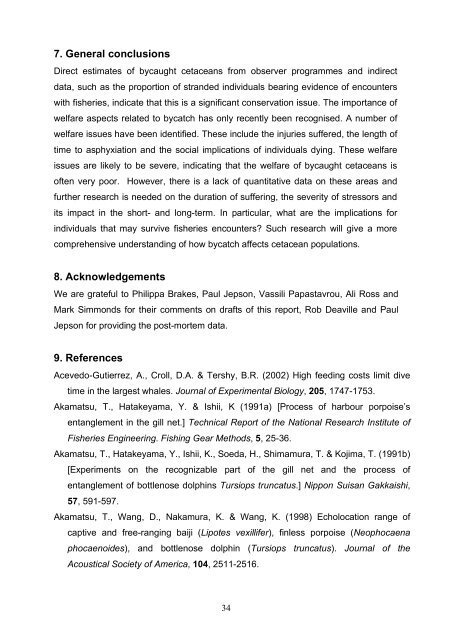The Animal Welfare Implications of Cetacean Deaths in Fisheries
The Animal Welfare Implications of Cetacean Deaths in Fisheries
The Animal Welfare Implications of Cetacean Deaths in Fisheries
Create successful ePaper yourself
Turn your PDF publications into a flip-book with our unique Google optimized e-Paper software.
7. General conclusions<br />
Direct estimates <strong>of</strong> bycaught cetaceans from observer programmes and <strong>in</strong>direct<br />
data, such as the proportion <strong>of</strong> stranded <strong>in</strong>dividuals bear<strong>in</strong>g evidence <strong>of</strong> encounters<br />
with fisheries, <strong>in</strong>dicate that this is a significant conservation issue. <strong>The</strong> importance <strong>of</strong><br />
welfare aspects related to bycatch has only recently been recognised. A number <strong>of</strong><br />
welfare issues have been identified. <strong>The</strong>se <strong>in</strong>clude the <strong>in</strong>juries suffered, the length <strong>of</strong><br />
time to asphyxiation and the social implications <strong>of</strong> <strong>in</strong>dividuals dy<strong>in</strong>g. <strong>The</strong>se welfare<br />
issues are likely to be severe, <strong>in</strong>dicat<strong>in</strong>g that the welfare <strong>of</strong> bycaught cetaceans is<br />
<strong>of</strong>ten very poor. However, there is a lack <strong>of</strong> quantitative data on these areas and<br />
further research is needed on the duration <strong>of</strong> suffer<strong>in</strong>g, the severity <strong>of</strong> stressors and<br />
its impact <strong>in</strong> the short- and long-term. In particular, what are the implications for<br />
<strong>in</strong>dividuals that may survive fisheries encounters Such research will give a more<br />
comprehensive understand<strong>in</strong>g <strong>of</strong> how bycatch affects cetacean populations.<br />
8. Acknowledgements<br />
We are grateful to Philippa Brakes, Paul Jepson, Vassili Papastavrou, Ali Ross and<br />
Mark Simmonds for their comments on drafts <strong>of</strong> this report, Rob Deaville and Paul<br />
Jepson for provid<strong>in</strong>g the post-mortem data.<br />
9. References<br />
Acevedo-Gutierrez, A., Croll, D.A. & Tershy, B.R. (2002) High feed<strong>in</strong>g costs limit dive<br />
time <strong>in</strong> the largest whales. Journal <strong>of</strong> Experimental Biology, 205, 1747-1753.<br />
Akamatsu, T., Hatakeyama, Y. & Ishii, K (1991a) [Process <strong>of</strong> harbour porpoise’s<br />
entanglement <strong>in</strong> the gill net.] Technical Report <strong>of</strong> the National Research Institute <strong>of</strong><br />
<strong>Fisheries</strong> Eng<strong>in</strong>eer<strong>in</strong>g. Fish<strong>in</strong>g Gear Methods, 5, 25-36.<br />
Akamatsu, T., Hatakeyama, Y., Ishii, K., Soeda, H., Shimamura, T. & Kojima, T. (1991b)<br />
[Experiments on the recognizable part <strong>of</strong> the gill net and the process <strong>of</strong><br />
entanglement <strong>of</strong> bottlenose dolph<strong>in</strong>s Tursiops truncatus.] Nippon Suisan Gakkaishi,<br />
57, 591-597.<br />
Akamatsu, T., Wang, D., Nakamura, K. & Wang, K. (1998) Echolocation range <strong>of</strong><br />
captive and free-rang<strong>in</strong>g baiji (Lipotes vexillifer), f<strong>in</strong>less porpoise (Neophocaena<br />
phocaenoides), and bottlenose dolph<strong>in</strong> (Tursiops truncatus). Journal <strong>of</strong> the<br />
Acoustical Society <strong>of</strong> America, 104, 2511-2516.<br />
34
















